List of Sicilian monarchs

The monarchs of Sicily ruled from the establishment of the Kingdom of Sicily in 1130 until the "perfect fusion" in the Kingdom of the Two Sicilies in 1816.
The origins of the Sicilian monarchy lie in the Norman conquest of southern Italy which occurred between the 11th and 12th century. Sicily, which was ruled as an Islamic emirate for at least two centuries, was invaded in 1071 by Norman House of Hauteville, who conquered Palermo and established a feudal county named the County of Sicily. The House of Hauteville completed their conquest of Sicily in 1091.
In 1130, the County of Sicily and the County of Apulia, ruled by different branches of the House of Hauteville, merged as the Kingdom of Sicily, and Count Roger II was crowned king by Antipope Anacletus II. In 1282, after the Sicilian Vespers, the kingdom split into separate states: the properly named "Ultra Sicily" (Siciliae ultra Pharum, Latin for "Sicily over the Strait") and "Hither Sicily" (Siciliae citra, commonly called "the Kingdom of Naples").[1] Definitive unification occurred in 1816, when Ferdinand IV and III made the two entities into a single state, the Kingdom of the Two Sicilies.[2][3]
Kings of Sicily
[edit]Roger II received royal investiture from Antipope Anacletus II in 1130 and recognition from Pope Innocent II in 1139. The Kingdom of Sicily, which by then comprised not only the island, but also the southern third of the Italian peninsula, rapidly expanded itself to include Malta and the Mahdia, the latter if only briefly.
House of Hauteville, 1130–1198
[edit]| Name | Portrait | Birth | Marriage(s) | Death | Claim |
|---|---|---|---|---|---|
| Roger II 1130–1154 |
 |
22 December 1095 Mileto son of Roger I of Sicily and Adelaide del Vasto |
Elvira of Castile 1117 6 children Sibyl of Burgundy 1149 2 children Beatrix of Rethel 1151 1 child |
26 February 1154 Palermo aged 58 |
Papal bull by Antipope Anacletus II |
| William I the Bad 1154–1166 |
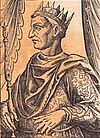 |
1121 son of Roger II and Elvira of Castile |
Margaret of Navarre 4 children |
7 May 1166 Palermo aged 45 |
Son of Roger II Agnatic primogeniture |
| William II the Good 1166–1189 |
 |
1155 son of William I and Margaret of Navarre |
Joan of England February 1177 1 child |
11 November 1189 Palermo aged 34 |
Son of William I Agnatic primogeniture |
| Tancred I 1189–1194 (joint rule) |
 |
1138 illegitimate son of Roger III, Duke of Apulia |
Sibylla of Acerra 6 children |
20 February 1194 Palermo aged 56 |
Illegitimate grandson of Roger II Seizure |
| Roger III 1193 (joint rule) |
 |
1175 son of Tancred of Sicily and Sibylla of Acerra |
Irene Angelina no children |
24 December 1193 aged 18 |
Son of Tancred I Agnatic primogeniture |
| William III 1194 |
 |
1190 son of Tancred and Sibylla of Acerra |
never married | 1198 aged 8 |
Son of Tancred I Agnatic primogeniture |
| Constance I 1194–1198 |
 |
2 November 1154 daughter of Roger II and Beatrix of Rethel |
Henry VI, Holy Roman Emperor 1184 1 child |
27 November 1198 Palermo aged 44 |
Posthumous daughter of Roger II Right of Conquest |
Constance was married to the Emperor Henry VI and he pressed his claim to the kingdom from William II's death, but only succeeded in displacing his wife's family in 1194.
There is evidence that, during the baronial revolt of 1197, there was an attempt to make Count Jordan Lupin of Bovino king in opposition to Henry VI. He may even have been crowned and seems to have had the support of Constance, who had turned against her husband. In the end he was captured and executed. He is accepted as a pretender to the throne by modern historians Evelyn Jamison and Thomas Curtis Van Cleve.
House of Hohenstaufen, 1194–1266
[edit]| Name | Portrait | Birth | Marriage(s) | Death | Claim |
|---|---|---|---|---|---|
| Henry I 1194–1197 |
 |
November 1165 Nijmegen son of Frederick I, Holy Roman Emperor and Beatrix of Burgundy |
Constance of Sicily 1184 1 child |
28 September 1197 Messina aged 32 |
Husband of Constance Jure uxoris |
| Frederick I 1198–1250 (joint rule) |
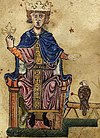 |
26 December 1194 Jesi son of Henry I and Constance I |
Constance of Aragon 15 August 1209 1 child Isabella II of Jerusalem 9 November 1225 2 children Isabella of England 15 July 1235 4 children |
13 December 1250 Torremaggiore aged 55 |
Son of Constance Jure matris |
| Henry II 1212–1217 (joint rule) |
 |
1211 Sicily son of Frederick II and Constance of Aragon |
Margaret of Austria 29 November 1225 2 children |
12 February 1242 Martirano aged 30 |
Son of Frederick I Agnatic primogeniture |
| Conrad I 1250–1254 |
 |
25 April 1228 Andria son of Frederick II and Isabella II of Jerusalem |
Elisabeth of Bavaria 1 September 1246 1 child |
21 May 1254 Lavello aged 26 |
Son of Frederick I Agnatic primogeniture |
| Conrad II the Younger aka Conradin 1254–1258 |
 |
25 March 1252 Wolfstein son of Conrad I and Elisabeth of Bavaria |
never married | 29 October 1268 Naples aged 16 (executed) |
Son of Conrad I Agnatic primogeniture |
| Manfred 1258–1266 |
 |
1232 Illegitimate son of Frederick II |
Beatrice of Savoy 21 April 1247 1 child Helena Angelina Doukaina 9 November 1255 5 children |
26 February 1266 Battle of Benevento aged 34 (killed in action) |
Illegitimate son of Frederick I Seizure |
Manfred was regent of Sicily for his nephew, the child Conrad II ("Conradin"), but took the crown in 1258, and continued to fight to keep the kingdom under the Hohenstaufen. In 1254 the pope, having declared the kingdom a Papal possession, offered the crown to the King of England's son, Edmund Crouchback, but the English never succeeded in taking the kingdom. In 1262 the pope reversed his previous decision and granted the kingdom to the King of France's brother, Charles of Anjou, who succeeded in dispossessing Manfred in 1266. Conradin continued his claim to the throne until his death by decapitation perpetrated by Charles of Anjou in 1268.
Edmund Crouchback, son of King Henry III of England, claimed the Crown of Sicily between 1254 and 1263. Both he and his father took the claim very seriously, but it was completely ineffectual.
Capetian House of Anjou, 1266–1282
[edit]| Name | Portrait | Birth | Marriage(s) | Death |
|---|---|---|---|---|
| Charles I 1266–1282 |
 |
21 March 1227 son of Louis VIII of France and Blanche of Castile |
Beatrice of Provence 31 January 1246 6 children Margaret of Nevers 18 November 1268 childless |
7 January 1285 Foggia aged 57 |
Peter III of Aragon, Manfred's son in law, of the House of Barcelona, conquered the island of Sicily from Charles I in 1282 and had himself crowned King of Sicily. Thereafter the old Kingdom of Sicily was centred on the mainland, with capital at Naples, and although informally called Kingdom of Naples it was still known formally as "Kingdom of Sicily". Thus, there were two "Sicilies" — the island kingdom, however, was often called "Sicily beyond the Lighthouse" or "Trinacria", by terms of a treaty between the two states.
House of Barcelona, 1282–1410
[edit]| Name | Portrait | Birth | Marriage(s) | Death | Claim |
|---|---|---|---|---|---|
| Constance II 1268/1282–1285 (joint rule) |
 |
1249 Sicily daughter of Manfred of Sicily and Beatrice of Savoy |
Peter I the Great 13 June 1262 6 children |
9 April 1302 Barcelona, Spain aged 52 or 53 |
Daughter of Manfred of Sicily Right of conquest |
| Peter I the Great 1282–1285 (joint rule) |
 |
1240 Valencia son of James I of Aragon and Yolanda of Hungary |
Constance of Sicily 13 June 1262 6 children |
2 November 1285 Vilafranca del Penedès aged 45 |
Husband of Constance II Jure uxoris |
| James the Just 1285–1295 |
 |
10 August 1267 Valencia son of Peter I and Constance of Sicily |
Isabella of Castile 1 December 1291 No children Blanche of Anjou 29 October 1295 10 children Marie de Lusignan 15 June 1315 No children Elisenda de Montcada 25 December 1322 No children |
5 November 1327 Barcelona aged 60 |
Son of Peter I and Constance II Salic patrimony |
| Frederick II 1295–1337 |
 |
13 December 1272 Barcelona son of Peter I and Constance of Sicily |
Eleanor of Anjou 17 May 1302 9 children |
25 June 1337 Palermo aged 65 |
Regent brother of James Election |
| Peter II 1337–1342 |
 |
July 1305 son of Frederick II and Eleanor of Anjou |
Elisabeth of Carinthia 23 April 1322 9 children |
15 August 1342 Calascibetta aged 37 |
Son of Frederick II Agnatic primogeniture |
| Louis 1342–1355 |
 |
1337 Catania son of Peter II and Elisabeth of Carinthia |
Never married | 16 October 1355 Aci Castello aged 18 |
Son of Peter II Agnatic primogeniture |
| Frederick III the Simple 1355–1377 |
1 September 1341 Catania son of Peter II and Elisabeth of Carinthia |
Constance of Aragon 11 April 1361 1 child Antonia of Balzo 17 January 1372 No children |
27 January 1377 Messina aged 36 |
Son of Peter II Brother of Louis Agnatic primogeniture | |
| Maria 1377–1401 (joint rule) |
 |
1363 Catania daughter of Frederick III and Constance of Aragon |
Martin I of Sicily 1390 1 child |
25 May 1401 Lentini aged 38 |
Daughter of Frederick III Cognatic primogeniture |
| Martin I the Younger 1390–1409 (joint rule) |
 |
1374 son of Martin I of Aragon (Martin II of Sicily) and Maria of Luna |
Maria of Sicily 1390 1 child |
25 July 1409 Cagliari aged 35 |
Husband of Maria Jure uxoris |
| Martin II the Elder 1409–1410 |
 |
1356 Girona son of Peter IV of Aragon and Eleanor of Sicily |
Maria de Luna 13 June 1372 4 children Margarita of Aragon-Prades 1409 No children |
31 May 1410 Barcelona aged 54 |
Maternal grandson of Peter II Cognatic primogeniture |
Martin II of Sicily died without an heir in 1410 and the kingdom was inherited by his nephew.
House of Trastámara, 1412–1516
[edit]| Name | Portrait | Birth | Marriage(s) | Death |
|---|---|---|---|---|
| Ferdinand I the Honest 1412–1416 |
 |
27 November 1380 Medina del Campo son of John I of Castile and Eleanor of Aragon |
Eleanor of Alburquerque 1394 8 children |
2 April 1416 Igualada aged 36 |
| Alfonso the Magnanimous 1416–1458 |
 |
1396 Medina del Campo son of Ferdinand I and Eleanor of Alburquerque |
Maria of Castile 1415 No children |
27 June 1458 Naples aged 52 |
| John the Great 1458–1468 |
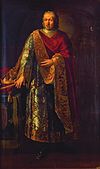 |
29 June 1397 Medina del Campo son of Ferdinand I and Eleanor of Alburquerque |
Blanche I of Navarre 6 November 1419 4 children Juana Enríquez 2 children |
20 January 1479 Barcelona aged 81 |
| Ferdinand II the Catholic 1468–1516 |
 |
10 March 1452 son of John II of Aragon and Juana Enriquez |
Isabella I of Castile 19 October 1469 5 children Germaine of Foix 1505 No children |
23 January 1516 Madrigalejo aged 63 |
| Joanna the Mad 1516–1555 |
 |
6 November 1479 daughter of Ferdinand II of Aragon and Isabella I of Castile |
Philip IV of Burgundy 1496 6 children |
12 April 1555 Madrigalejo aged 75 |
Joanna was confined under alleged insanity during her whole reign.
House of Habsburg, 1516-1700
[edit]| Name | Portrait | Birth | Marriage(s) | Death |
|---|---|---|---|---|
| Charles II 1516–1556 |
 |
24 February 1500 Ghent son of Philip I of Castile and Joanna of Castile |
Isabella of Portugal 10 March 1526 3 children |
21 September 1558 Yuste aged 58 |
| Philip I 1554–1598 |
 |
21 May 1527 Valladolid son of Charles I and Isabella of Portugal |
Maria of Portugal 1543 1 child Mary I of England 1554 No children Elisabeth of Valois 1559 2 children Anna of Austria 4 May 1570 5 children |
13 September 1598 Madrid aged 71 |
| Philip II 1598–1621 |
 |
14 April 1578 Madrid son of Philip I and Anna of Austria |
Margaret of Austria 18 April 1599 5 children |
31 March 1621 Madrid aged 42 |
| Philip III 1621–1665 |
 |
8 April 1605 Valladolid son of Philip II and Margaret of Austria |
Elisabeth of Bourbon 1615 7 children Mariana of Austria 1649 5 children |
17 September 1665 Madrid aged 60 |
| Charles III 1665–1700 |
 |
6 November 1661 Madrid son of Philip III and Mariana of Austria |
Maria Luisa of Orléans 19 November 1679 No children Maria Anna of Neuburg 14 May 1690 No children |
1 November 1700 Madrid aged 38 |
House of Bourbon, 1700-1713, during War of the Spanish Succession
[edit]| Name | Portrait | Birth | Marriage(s) | Death |
|---|---|---|---|---|
| Philip IV 1700–1713 |
 |
19 December 1683 Versailles son of Louis, Dauphin of France and Maria Anna of Bavaria |
Maria Luisa of Savoy 2 November 1701 4 children Elisabeth of Parma 24 December 1714 7 children |
9 July 1746 Madrid aged 62 |
At the end of the War of the Spanish Succession, by the Treaty of Utrecht, Sicily was ceded to the Duke of Savoy.
House of Savoy, 1713–1720
[edit]| Name | Portrait | Birth | Marriage(s) | Death |
|---|---|---|---|---|
| Victor Amadeus 1713–1720 |
 |
14 May 1666 Turin son of Charles Emmanuel II, Duke of Savoy and Marie Jeanne Baptiste de Savoie-Nemours |
Anne Marie of Orléans 10 April 1684 6 children |
31 October 1732 Moncalieri aged 66 |
The Spanish invaded the kingdom in 1718 during the War of the Quadruple Alliance. The Duke of Savoy ceded it to Austria in 1720 by the Treaty of The Hague.
House of Habsburg, 1720–1735
[edit]| Name | Portrait | Birth | Marriage(s) | Death |
|---|---|---|---|---|
| Charles IV 1720–1735 |
 |
1 October 1685 Vienna son of Leopold I, Holy Roman Emperor and Eleonore-Magdalena of Pfalz-Neuburg |
Elisabeth Christine 1 August 1708 4 children |
20 October 1740 Vienna aged 55 |
Charles I, Duke of Parma conquered the kingdom during the War of the Polish Succession. At the end of the war, Sicily was ceded to him as Charles III of Sicily.
House of Bourbon 1735–1816
[edit]| Name | Portrait | Birth | Marriage(s) | Death |
|---|---|---|---|---|
| Charles V 1735–1759 |
 |
20 January 1716 Madrid son of Philip IV and Elizabeth of Parma |
Maria Amalia of Saxony 1738 13 children |
14 December 1788 Madrid aged 72 |
| Ferdinand III 1759–1816 |
 |
12 January 1751 Naples son of Charles III and Maria Amalia of Saxony |
Marie Caroline of Austria 12 May 1768 17 children Lucia Migliaccio of Floridia 27 November 1814 No children |
4 January 1825 Naples aged 73 |
In 1816 the Kingdom of Naples and the Kingdom of Sicily were merged as the new Kingdom of the Two Sicilies.
House of Bourbon-Two Sicilies 1816–1861
[edit]| Portrait | Coat of arms | Name | Reign | Relationship with predecessor(s) | Title | |
|---|---|---|---|---|---|---|

|

|
Ferdinand I (Ferdinando I) |
12 December 1816 | 4 January 1825 | • Son of Charles III of Spain | King of the Two Sicilies (Rè delle Due Sicilie) |
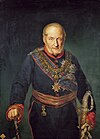
|

|
Francis I (Francesco I) |
4 January 1825 | 8 November 1830 | • Son of Ferdinand I | King of the Two Sicilies (Rè delle Due Sicilie) |

|

|
Ferdinand II (Ferdinando II) |
8 November 1830 | 22 May 1859 | • Son of Francis I | King of the Two Sicilies (Rè delle Due Sicilie) |
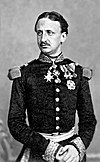
|

|
Francis II (Francesco II) |
22 May 1859 | 20 March 1861 | • Son of Ferdinand II | King of the Two Sicilies (Rè delle Due Sicilie) |
Heads of the Royal House of Two Sicilies
[edit]| Portrait | Coat of arms | Name | Reign | Relationship with predecessor(s) | Title | |
|---|---|---|---|---|---|---|

|

|
Prince Alfonso of Bourbon-Two Sicilies | 27 December 1894 | 26 May 1934 | • Brother of King Francis II | Count of Caserta |

|

|
Prince Ferdinand Pius of Bourbon-Two Sicilies | 26 May 1934 | 7 January 1960 | • 1st Son of Prince Alfonso, Count of Caserta | Duke of Calabria |
| Portrait | Coat of arms | Name | Reign | Relationship with predecessor(s) | Title | |
|---|---|---|---|---|---|---|

|

|
Prince Alfonso of Bourbon-Two Sicilies | 7 January 1960 | 3 February 1964 | • Son of Prince Carlos of Bourbon-Two Sicilies, 2nd son of Prince Alfonso, Count of Caserta | Infante of Spain Duke of Calabria Count of Caserta |

|
Prince Carlos of Bourbon-Two Sicilies | 3 February 1964 | 5 October 2015 | • Son of Infante Alfonso, Duke of Calabria | Infante of Spain Duke of Calabria Count of Caserta | |

|

|
Prince Pedro of Bourbon-Two Sicilies | 5 October 2015 | • Son of Infante Carlos, Duke of Calabria | Grandee of Spain Duke of Calabria Count of Caserta | |
| Portrait | Coat of arms | Name | Reign | Relationship with predecessor(s) | Title | |
|---|---|---|---|---|---|---|

|

|
Prince Ranieri of Bourbon-Two Sicilies | 7 January 1960 | 13 January 1973 | • 3rd Son of Prince Alfonso, Count of Caserta | Duke of Castro |

|
Prince Ferdinand of Bourbon-Two Sicilies | 13 January 1973 | 20 March 2008 | • Son of Prince Ranieri, Duke of Castro | Duke of Castro | |

|

|
Prince Carlo of Bourbon-Two Sicilies | 20 March 2008 | • Son of Prince Ferdinand, Duke of Castro | Duke of Castro | |
Family tree
[edit]See also
[edit]- List of Sicilian consorts
- List of viceroys of Sicily
- County of Apulia and Calabria
- List of monarchs of Naples
- List of monarchs of the Two Sicilies
References
[edit]- ^ "Vespri siciliani nell'Enciclopedia Treccani". www.treccani.it (in Italian). Retrieved 20 July 2021.
- ^ "Ferdinand I | king of the Two Sicilies". Encyclopedia Britannica. Retrieved 20 July 2021.
- ^ "Due Sicilie, regno delle in "Dizionario di Storia"". www.treccani.it (in Italian). Retrieved 20 July 2021.

